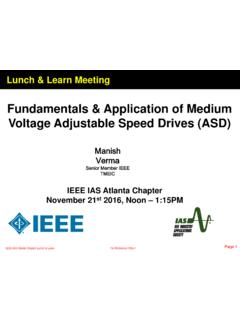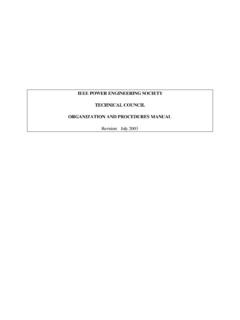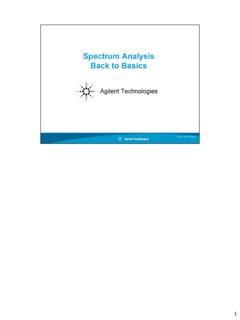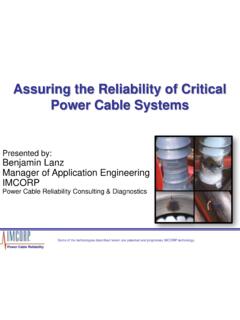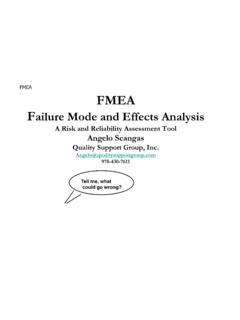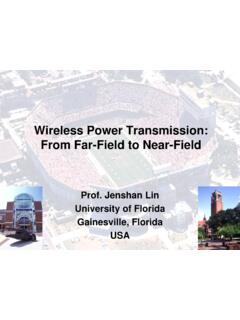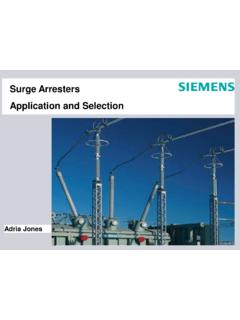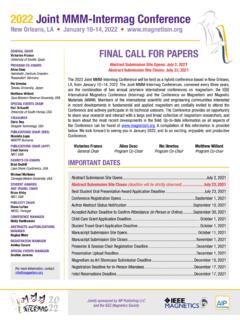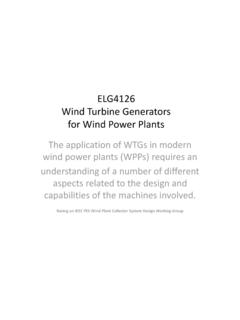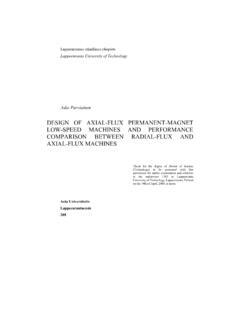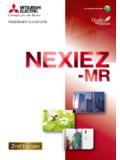Transcription of Wind Farm Electrical Systems.pptx [Read-Only]
1 Wind Farm Electrical Systems History of Wind Power Pitstone Windmill, believed to be the oldest windmill in the British Isles The Giant Brush Windmill in Cleveland, Ohio During the winter of 1887 88 Brush built what is today believed to be the first automatically operating wind turbine for electricity generation. It was a giant the World's largest with a rotor diameter of 17 m (50 ft.). and 144 rotor blades made of cedar wood. Note the person mowing the lawn to the right of the wind turbine. The turbine ran for 20 years and charged the batteries in the cellar of his mansion.
2 Despite the size of the turbine, the generator was only a 12 kW model. Grandpa's Knob The first large scale electricity producing windmill (the world's largest at the time) was installed in 1941 at Grandpa's Knob, on the border of Castleton and West Rutland, VT, to take advantage of New England's strong wind energy regime. The turbine restarted on March 3, 1945 and operated normally until March 26, when the turbine suffered a massive failure. One of the 75 foot blades suddenly snapped off and hurled 700 feet down the mountain. The experiment, still largely considered a success, ended with the turbine being razed in the summer of 1946.
3 Wind Turbine Generator Introduction A small anemometer and wind vane on top of the wind turbine electronically tell a controller which way to point the rotor into the wind. Then the "yaw drive" mechanism turns gears to point the rotor into the wind. Nacelle design 1. Maintenance Hoist. Nacelle Details 2. Generator: 800 kW, Induction, 4 poles, 690 Volts. 3. Cooling system (Air). 4. Top Control unit. (PLC). 5. Gear box: ratio 6. Main shaft 7. Maintenance Rotor Lock System. 8. Blade. 9. Blade Hub 10. Nose cone 11. Blade bearing (for pitch control). 12. Base Frame 13.
4 Hydraulic Unit (disk brakes, gear box ). 14. Gear frame attachment 15. Yaw Ring 16. Brake 17. Tower (three sections). 18. Yaw motor drive: kW. 19. Cardan 20. Windvane for yaw control. 21. Anemometer for pitch control. Nacelle Details Induction (Asynchronous) machine Induction machine Reactive Power Wind Turbine Induction Generator Induction Generator Issues Capacitors require to provide excitation Fixed speed operation only Gearbox torque is of concern Can't provide reactive or voltage control Uncompensated wind farm is a consumer of reactive power (see chart). Reactive power compensation is needed to control the voltage Wound Rotor Induction machine Wound Rotor Induction Generator Singly Fed Induction Generator Doubly Fed Induction Generator Converter Rotor Energy Dissipated Absorbs Over speed Rotor Energy & Provides Output Energy Doubly Fed Induction Generator Converter Absorbs Energy for Under speed Rotor & Provides Output Energy Wind Turbine Generator Constant Speed Systems Squirrel Cage Induction Generator Cheap & Simple Torque variations not compensated Flicker Capacitors to compensate reactive power Wind Turbine
5 Generator Variable Speed Systems Doubly Fed (Wound Rotor) Induction Generator DFIG. Optimum power control Converter size Restricted speed variability Expensive Wind Turbine Generator Variable Speed Systems Squirrel Cage Induction Generator Optimum power control 100% speed variability Converter size Expensive Wind Turbine Generator Variable Speed Systems permanent magnet Synchronous Generator Optimum power control 100% speed variability Without Gearbox Converter size Generator complexity Very expensive WT Generator Comparison Wind Farms A wind farm is a collection of wind turbines in the same location.
6 Wind turbines are often grouped together in wind farms because this is the most economical way to create electricity from the wind. If multiple wind turbines are placed too close to one another, the efficiency of the turbines will be reduced. Each wind turbine extracts some energy from the wind, so directly downwind of a turbine winds will be slower and more turbulent. For this reason, wind turbines in a wind farm are typically placed 3 5 rotor diameters apart perpendicular to the prevailing wind and 5 10 rotor diameters apart parallel to the prevailing wind. Energy loss due to the "Wind Park Effect" may be 2 5%.
7 The largest wind farm in the world is in Texas. It has 421 wind turbines spread out over 47,000 acres. This wind farm can produce a total of Megawatts of electricity. Wind Farm Layout to minimize "Wind Park Effect". Comparison Wind Farm & Conventional Power Plant Wind Farm Conventional Power Plant Configuration Multiple small generators One large generator Location Determinate on wind Sited for economics speed (transmission access). Control 1st Generation had no Voltage & Frequency voltage ride through Reactive Power Capacitor banks and Self generated power electronics Reliability Output varies with wind Output predictable Generator Reactive Capability Induction generators no inherent Lagging reactive production capability MVar MW.
8 Leading Lagging Doubly fed induction generators pf +.95. +/ pf MVar MW. Leading .95p f Synchronous Generator reactive Lagging capability MVar MW. Leading First Generation Wind Turbines Small Output (less than 1 MW). Fixed Speed Induction Generator Required Capacitive Compensation To Operate No Low Voltage Ride Through (LVRT); Tripped Off For Low System Voltage No Reactive Power Support No SCADA Control/Data to System Operator Low Penetration Level In Grid August 2003 Blackout Higher System Penetration (5 10%). No LVRT/Reactive Support Aggravated Situation FERC Order No.
9 661 A, Interconnection for Wind Energy (NERC Member Grid Codes Also). Three Common Components To Grid Codes: 1. LVRT Requirements 2. Reactive Power; Provide +/ PF and Dynamic Reactive Support If Required 3. Provide Data to Transmission Operator (SCADA). Low Voltage Ride Through FERC 661A. First Generation WTG No LVRT. 1. Fault on utility transmission grid 2. Transmission system voltage drops rapidly. 5. Voltage returns to normal. But, no generation remains on line. 3. Wind generation 4. Fault clears trips off line because in 600 mS. voltage is below pu at generator terminals for 5 cycles.
10 WTG with SVC (or enhanced DFIG). 1. Fault on utility transmission grid 2. Transmission system voltage drops rapidly. 3. SVC detects low voltage and injects reactive energy to quickly rebuild voltage at the wind generator above pu threshold Reactive Power Compensation Shunt capacitors, switched in blocks, relatively inexpensive, not good for transient events Switching block of capacitance can swing the voltage up or down and this variation is felt as an abrupt change in torque on the turbine gearboxes Static var Compensators Provide Continuously Adjustable Dynamic +/ PF Control, Very Expensive SVC Configuration Compensation Cap Bank vs SVC.
